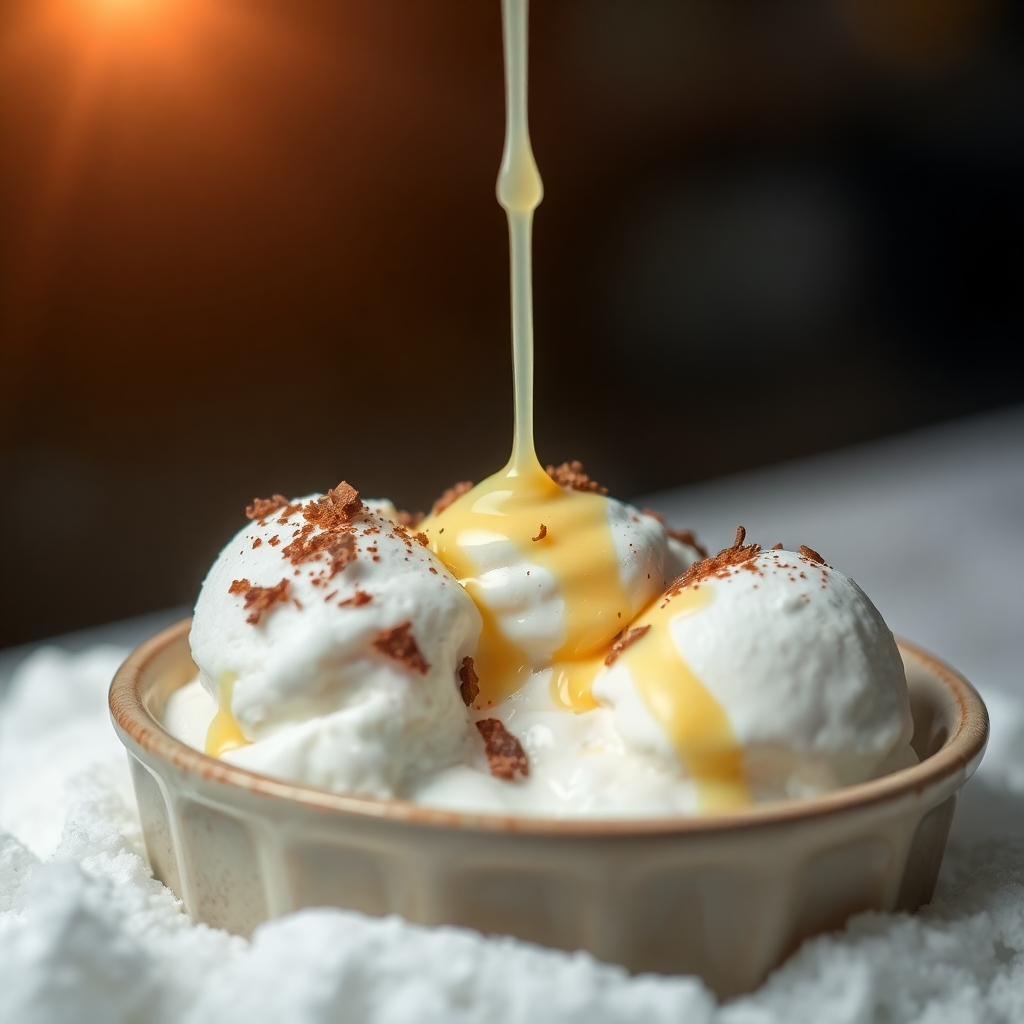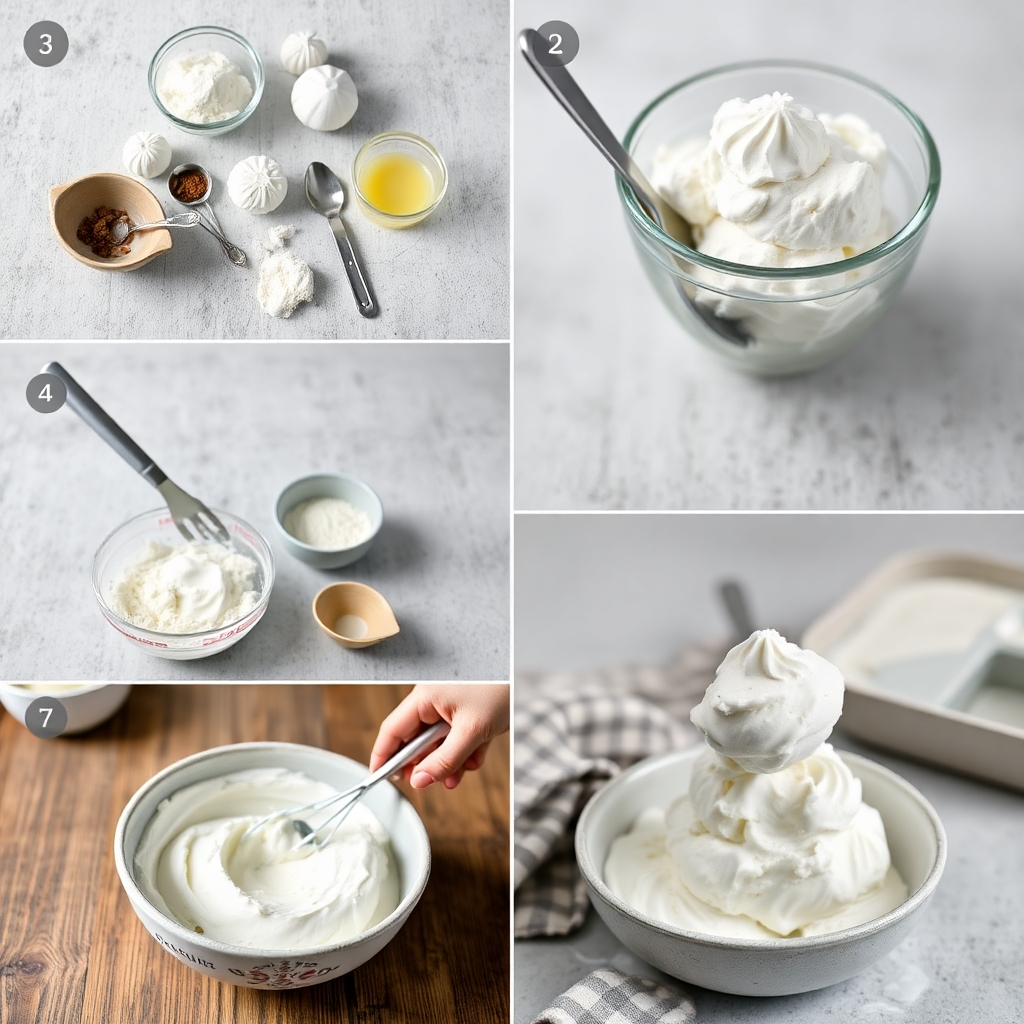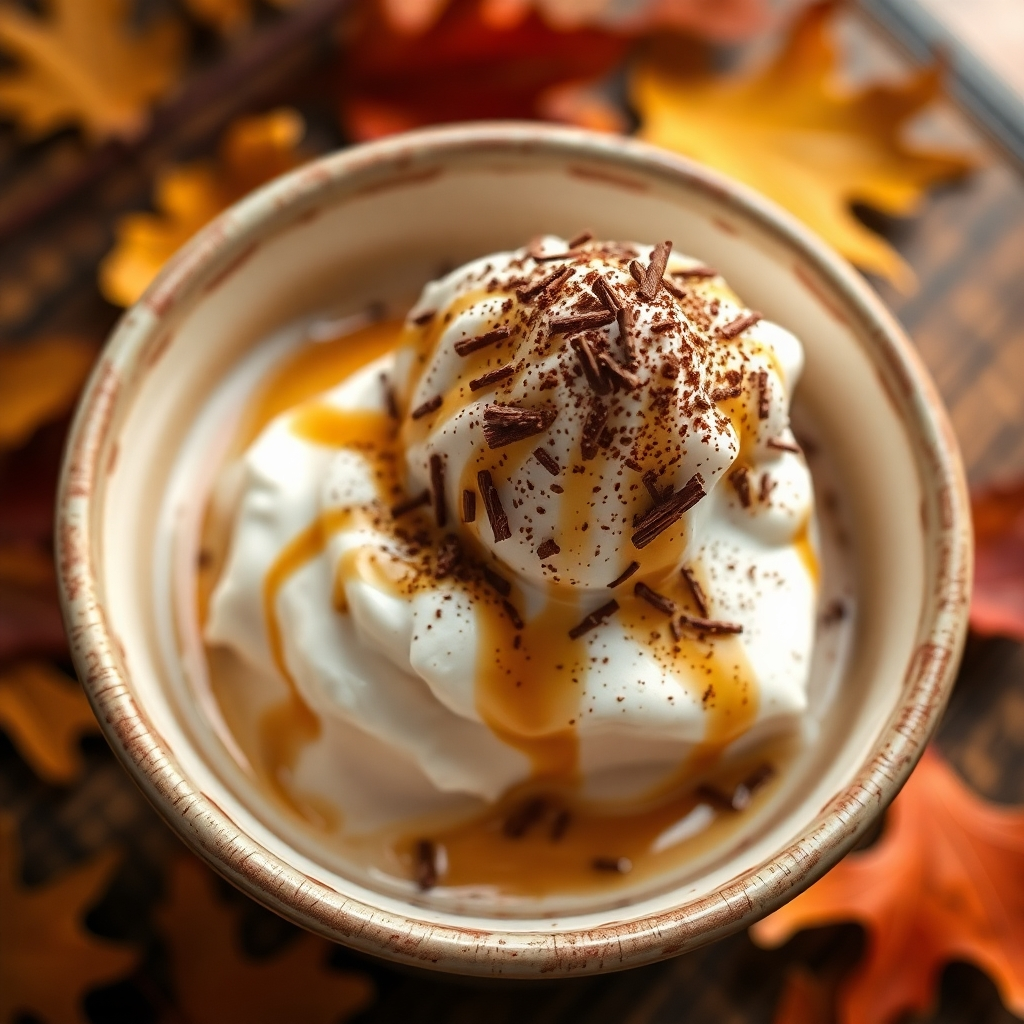There’s something truly magical about waking up to a world blanketed in pristine white snow. While snowball fights and snowman-building might be the first activities that come to mind, there’s another delightful tradition that transforms an ordinary snow day into something extraordinary: homemade snow cream. This simple yet enchanting winter dessert turns freshly fallen snow into a creamy, sweet treat that captures the essence of childhood wonder.
In this comprehensive guide, I’ll share everything you need to know about creating the perfect snow cream. From collecting the right kind of snow to innovative flavor combinations that will delight everyone in your family, you’ll discover why this ephemeral dessert has remained a beloved winter tradition for generations. The best part? You likely already have all the ingredients you need in your kitchen pantry!
What Is Snow Cream?
The Magic of Snow Transformed
Snow cream (sometimes called snow ice cream) is a simple homemade dessert made by mixing fresh, clean snow with sweetened dairy or dairy alternatives and flavorings. The result is a delightful treat with the consistency somewhere between ice cream and a snow cone—creamy yet still maintaining that distinctive crystalline texture of fresh snow.
Unlike store-bought frozen desserts, snow cream can’t be mass-produced or preserved. It’s an ephemeral treat that exists only in the moment, making it all the more special. This dessert has been delighting children and adults alike for generations, providing a sweet reward for braving cold winter weather.
Why Snow Cream Captivates Us
What makes snow cream so special isn’t just its taste but the entire experience surrounding it. The anticipation as snowflakes begin falling, the excitement of rushing outside with a bowl to collect pristine powder, and the joy of transforming an everyday natural phenomenon into something deliciously unexpected—these elements create not just a dessert but a memory.
In our modern world of convenience foods and instant gratification, snow cream stands apart as something you simply cannot buy—it must be made, and only when nature provides the essential ingredient. This connection to seasonality and nature’s rhythms is increasingly rare and precious.
The History and Tradition of Snow Cream
Ancient Origins of Snow Desserts
The practice of mixing snow with sweeteners to create refreshing treats dates back surprisingly far in human history. Historical records show that as early as the first century AD, Roman Emperor Nero enjoyed snow mixed with honey and fruit nectar as a luxurious indulgence. Servants would collect mountain snow and run it down to Rome in relay races, storing it in special underground chambers.
In 12th century China, there are accounts of mixing snow with milk and syrup, showing that the concept of snow cream has existed across different cultures for centuries. These early versions weren’t exactly like today’s snow cream, but they demonstrate humanity’s long-standing desire to transform snow into something delicious.
American Snow Cream Traditions
In America, snow cream became particularly popular in rural communities and across the Southern United States, where snowfall was less common and therefore more special. When winter storms blanketed regions that typically saw little snow, families would rush outside with bowls to collect fresh powder, turning weather events into opportunities for rare treats.
The tradition became especially cherished before modern refrigeration when ice cream was a luxury only available to the wealthy or during special occasions. Snow cream provided an accessible alternative that anyone could make with simple ingredients found in most kitchen pantries.

Regional Variations
Like many traditional recipes, snow cream varies significantly by region:
- Southern snow cream typically features vanilla extract and sweetened condensed milk
- New England versions often incorporate maple syrup instead of processed sugar
- Appalachian recipes sometimes add a pinch of salt to enhance sweetness
- Midwestern snow cream might include heavy cream for extra richness
- European variations sometimes incorporate fruit preserves or even liqueurs for adult versions
Family Recipes Passed Through Generations
What makes snow cream particularly special is how recipes have been passed down through families. Many people have fond memories of watching grandparents or parents eagerly collecting fresh snow and mixing up this ephemeral dessert, creating memories that last far longer than the treat itself. These family traditions often include special techniques, secret ingredients, or specific serving dishes that only come out during snowfalls.
Essential Ingredients for Perfect Snow Cream
The Star Ingredient: Fresh Snow
The most important component of snow cream is, of course, fresh snow. But not just any snow will do. For the best results:
- Collect snow shortly after it has fallen, ideally at least an hour into a steady snowfall
- Gather from a clean, undisturbed area away from roads, walkways, and areas where pets or wildlife might visit
- Target the top layer of deeper accumulations, avoiding snow that’s in direct contact with the ground
- Use a clean container specifically set aside for snow collection
- Collect more than you think you’ll need—snow compacts significantly when mixed with other ingredients
A general rule of thumb is to gather about 8-10 cups of fresh snow to make 4 servings of snow cream, though you’ll likely need to adjust based on the snow’s consistency.
Base Ingredients for Classic Snow Cream
Traditional snow cream requires just a few pantry staples:
- Sweetened condensed milk: This provides both sweetness and richness in one ingredient, giving snow cream its distinctive velvety texture
- Vanilla extract: For classic flavor (pure vanilla extract offers the best taste)
- A pinch of salt: Optional but enhances flavor by balancing sweetness
- Regular milk or cream: Sometimes added to adjust consistency
Alternative Base Ingredients
For those with dietary restrictions or preferences, snow cream can be easily adapted:
- Dairy-free option: Coconut milk or condensed coconut milk creates a delicious alternative
- Less sweet version: Whole milk or half-and-half with sugar to taste
- Natural sweetener option: Maple syrup or honey (use slightly less as they’re more intensely sweet)
- Vegan snow cream: Plant-based milk with sugar and vanilla
Tools and Equipment
One of the beauties of snow cream is its simplicity. You’ll need:
- Large mixing bowl (metal bowls work particularly well as they keep the mixture cold)
- Measuring cups and spoons
- Sturdy spatula or wooden spoon for mixing
- Serving bowls
- Optional: ice cream scoop for serving
Step-by-Step Snow Cream Recipe

Classic Vanilla Snow Cream Recipe
Ingredients:
- 8-10 cups fresh, clean snow
- 1 can (14 oz) sweetened condensed milk
- 1 teaspoon pure vanilla extract
- Pinch of salt (optional, but enhances flavor)
Instructions:
- Prepare your mixture: In a small bowl, combine the sweetened condensed milk, vanilla extract, and optional pinch of salt. Stir until well mixed and set aside.
- Collect your snow: Using a clean container, gather fresh snow from an undisturbed area. Collect more than you think you’ll need, as the snow will compact when mixed with liquid ingredients.
- Combine ingredients: Place about 8 cups of snow in a large mixing bowl. Drizzle the sweetened condensed milk mixture over the snow.
- Mix gently: Using a spatula or wooden spoon, fold the liquid into the snow with a light touch. Mix just until combined—overmixing will cause the snow to melt too quickly. The goal is to incorporate the sweetened condensed milk mixture while maintaining as much of the snow’s texture as possible.
- Adjust consistency: The perfect snow cream should have the consistency of soft-serve ice cream. If your mixture seems too dry, add a little more of the sweetened condensed milk mixture. If it’s too wet or runny, add more snow.
- Serve immediately: Transfer to serving bowls and enjoy right away! Snow cream waits for no one—it’s best enjoyed immediately after preparation.
Alternative Basic Recipe (Using Regular Milk)
If you don’t have sweetened condensed milk on hand:
Ingredients:
- 8-10 cups fresh snow
- 1 cup milk (whole milk works best)
- 1/2 cup granulated sugar
- 1 teaspoon vanilla extract
- Pinch of salt (optional)
Instructions:
Follow the same mixing procedure as above, but first stir the sugar into the milk until dissolved before adding vanilla and combining with snow.
Tips for Perfect Texture
- Work quickly: The longer you take, the more the snow will melt
- Pre-chill your bowl and utensils: Place your mixing bowl in the freezer for 15 minutes before making snow cream
- Don’t overmix: Gentle folding preserves the snow’s texture
- Adjust as you go: Every snowfall is different (powdery, wet, etc.) so be ready to adapt your recipe
- Keep ingredients cold: Store milk products in the refrigerator until the last moment
Troubleshooting Common Issues
- Too runny: The snow may have been too wet or started melting. Add more fresh snow and work quickly.
- Too dry or grainy: Add a splash more of your milk mixture and gently incorporate.
- Too sweet: Add a small amount of plain snow to dilute.
- Not sweet enough: Drizzle in a little more sweetened condensed milk or a sprinkle of sugar.
- Iciness or crystallization: This usually happens if the mixture sits too long. Unfortunately, the best solution is to start fresh.
Creative Flavor Variations and Mix-ins
Classic Flavor Variations
Once you’ve mastered the basic recipe, it’s time to experiment with flavors:
Chocolate Snow Cream
Add 2-3 tablespoons of cocoa powder to your milk mixture before combining with snow. For a richer chocolate flavor, use chocolate syrup or melted chocolate chips.
Strawberry Snow Cream
Stir in 3-4 tablespoons of strawberry syrup or 1/4 cup of pureed fresh strawberries to the basic recipe.
Maple Cinnamon Snow Cream
Replace the vanilla extract with 2 tablespoons of pure maple syrup and add 1/4 teaspoon of ground cinnamon.
Coffee Snow Cream
Add 1 tablespoon of instant coffee powder to your milk mixture, or use strongly brewed coffee in place of some of the milk.
Gourmet Snow Cream Creations
Take your snow cream to the next level with these sophisticated variations:
Salted Caramel Snow Cream
Drizzle caramel sauce into your snow cream and add a pinch of flaky sea salt on top.
Honey Lavender Snow Cream
Replace sugar with 3 tablespoons of honey and add 1/2 teaspoon of culinary lavender (finely chopped).
Matcha Green Tea Snow Cream
Add 1 tablespoon of matcha powder to your milk mixture for a beautiful green color and earthy flavor.
Coconut Snow Cream
Use coconut milk instead of regular milk and add 1/4 cup toasted coconut flakes.
Kid-Friendly Fun Mix-ins
Get the little ones involved with these fun additions:
- Mini chocolate chips
- Colorful sprinkles
- Crushed cookies
- Breakfast cereal pieces
- Gummy bears
- Fruit loops or other colorful cereals
- Mini marshmallows
- Crushed candy canes (for a wintery peppermint flavor)
Create a Snow Cream Bar
For parties or family fun, set up a snow cream bar with:
- A large bowl of fresh basic snow cream
- Various toppings in small bowls
- Syrups and sauces in squeeze bottles
- Sprinkles and candies
- Fruit pieces
- Nuts and cookie crumbles
This interactive dessert experience is perfect for snow days and creates wonderful memories while letting everyone customize their own treat.
Safety Considerations When Making Snow Cream
Guidelines for Collecting Clean Snow
While snow cream is a delightful treat, safety should always be a priority:
- Wait for fresh snowfall: The best snow for snow cream is freshly fallen, preferably after the first hour of steady snowfall
- Choose the right location: Collect snow from elevated, clean surfaces away from roads, walkways, and areas where animals might visit
- Avoid colored or dirty snow: Only use pristine white snow
- Skip the ground layer: The top layer of snow is typically the cleanest, so avoid scraping all the way to the ground
- Use clean collection containers: Designate specific clean containers for snow collection
When to Avoid Making Snow Cream
There are some situations when it’s better to skip making snow cream:
- During pollution advisories or poor air quality days
- In heavily urban areas with significant air pollution
- During light dustings when you can’t collect snow from deep, clean areas
- If the snow has unusual coloration or debris
- If you’re in an area with known environmental contaminants
Food Safety Considerations
Like any food preparation, proper hygiene is important:
- Wash hands thoroughly before collecting snow and preparing snow cream
- Use clean utensils and bowls
- Consume snow cream immediately, as it doesn’t store well and can develop bacteria if left at room temperature
- Be aware that snow cream contains raw ingredients (milk products) that should be consumed promptly
Alternatives When Fresh Snow Isn’t Available
No snow? No problem! Try these alternatives:
Shaved Ice Cream
- Freeze a shallow pan of milk or cream mixture until solid
- Scrape with a fork to create a snow-like texture
- Mix with condensed milk and flavorings
Blender Snow Cone
- Blend ice cubes in a powerful blender until they reach a snow-like consistency
- Add the sweetened milk mixture as you would with regular snow cream
Store-Bought Alternative
In a pinch, vanilla ice cream softened and mixed with whipped cream can provide a similar texture and experience
Frequently Asked Questions About Snow Cream
Is snow cream safe to eat?
Snow cream made from freshly fallen, clean snow is generally considered safe for most people. The key is collecting clean snow from unpolluted areas, away from roads or areas with animal traffic. Waiting until the second hour of snowfall allows the snow to essentially “clean” the air as it falls. As with any food containing dairy products, those with compromised immune systems, pregnant women, very young children, or elderly individuals may want to exercise additional caution.
How long does snow cream last?
Snow cream is best enjoyed immediately after making it. Unlike commercial ice cream, it doesn’t contain stabilizers or undergo professional freezing processes. If you must store leftovers, keep them in the freezer in an airtight container for no more than 1-2 days, but be aware the texture will change significantly, often becoming icy rather than creamy.
Can I make snow cream with non-dairy alternatives?
Absolutely! Snow cream is incredibly adaptable to dietary needs. Use coconut milk, almond milk, or oat milk instead of dairy. Condensed coconut milk works well as a replacement for sweetened condensed milk. Just be aware that plant-based milks may freeze differently, so you might need to adjust the ratios slightly.
Why did my snow cream turn out runny?
Several factors can cause runny snow cream:
- The snow was too wet or heavy with moisture
- The snow started melting before mixing was complete
- Too much liquid was added to the snow
- The mixing bowl was warm
Try using colder, fluffier snow, pre-chilling your bowl, working quickly, and starting with less liquid (you can always add more).
Can I make snow cream ahead of time?
Unfortunately, snow cream doesn’t lend itself well to advance preparation. The magic of snow cream is in its freshness and the transformation of snow into a dessert. The best approach is to prepare your liquid mixture ahead of time and refrigerate it, then collect snow and complete the mixing just before serving.
What’s the best type of snow for snow cream?
Light, fluffy, powdery snow makes the best snow cream. This type of snow, which typically falls during colder temperatures, has a lower moisture content and creates a lighter, airier finished product. Heavy, wet snow tends to melt quickly and can result in a runnier consistency.
Is snow cream the same as ice cream?
While similar in appearance and basic concept, snow cream differs from traditional ice cream in several ways. Snow cream uses actual snow as its base and doesn’t require churning or freezing. It’s made in minutes rather than hours, has a lighter texture, and is less dense than ice cream. Consider it ice cream’s rustic, ephemeral cousin that makes a special appearance only during snowfall.
Making Snow Cream a Winter Tradition
Creating Memorable Experiences
Beyond just being a tasty treat, making snow cream can become a cherished family tradition:
- Designate special “snow cream bowls” that only come out during snowfalls
- Create a family ritual around the first substantial snowfall of the year
- Take photos each year of your snow cream adventures
- Start a “snow cream journal” recording the date, snow quality, and recipe variations
- Share your family’s special recipe with neighbors during snow days
Educational Opportunities
Making snow cream can also be educational for children:
- Discuss the science of snow formation
- Observe how different snow conditions affect the final product
- Explore measurements and ratios while adjusting recipes
- Learn about food safety and hygiene
- Discover cultural food traditions from around the world
Snow Cream Parties
When the forecast calls for significant snowfall, consider planning a snow cream social:
- Invite neighbors to bring creative toppings
- Hold friendly competitions for the most creative flavor combination
- Make multiple batches with different base recipes for comparison
- Pair with hot cocoa for a perfect winter contrast
- Create a cozy indoor setting with winter decorations
Conclusion: The Timeless Joy of Snow Cream
There’s something wonderfully nostalgic and magical about snow cream. In our modern world of convenience foods and mass-produced treats, snow cream stands apart as something you simply cannot buy—it must be made, and only when nature provides the essential ingredient. This ephemeral dessert connects us to simpler times and reminds us to appreciate the special gifts of winter.
The joy of snow cream isn’t just in the eating—it’s in the entire experience: the excitement of waking up to a snow-covered world, the rush to collect pristine powder before it’s disturbed, the family gathering in the kitchen with cold-reddened cheeks, and the delight of transforming ordinary snow into a sweet treat. These are the moments that create lasting memories.
Whether you’re making snow cream using a recipe passed down through generations or trying it for the first time with your own family, you’re participating in a timeless winter tradition. The simplicity of snow cream—requiring just a few basic ingredients and no special equipment—makes it accessible to almost everyone, while its endless variations provide room for creativity and personalization.
So the next time snowflakes begin to fall, grab a bowl and head outside. That magical winter dessert awaits, ready to transform an ordinary snow day into an extraordinary memory. After all, the best snow cream recipe isn’t just about food—it’s about the moments we create and share with those we love.


1 thought on “How to Make Snow Cream: Easy & Delicious Winter Dessert Recipe”